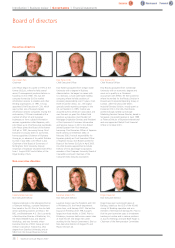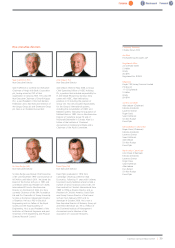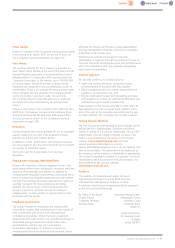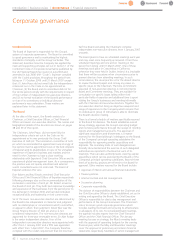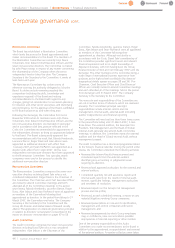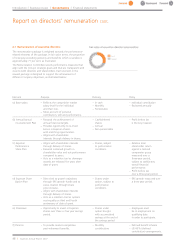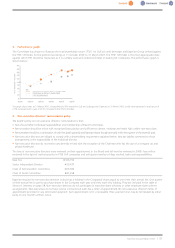Experian 2007 Annual Report Download - page 48
Download and view the complete annual report
Please find page 48 of the 2007 Experian annual report below. You can navigate through the pages in the report by either clicking on the pages listed below, or by using the keyword search tool below to find specific information within the annual report.
•Risks were methodically anticipated, identified, assessed
and appropriately mitigated as part of an enterprise
wide risk management process operating throughout
the Group on an ongoing basis.
•Senior management made presentations on risk to the
Audit Committee, which reported regularly to the Board
on the risks facing the Group’s business.
•The Audit Committee has delegated responsibility from
the Board for considering operational, financial and
compliance risks on a regular basis and received its
annual report on the controls over these risks. This
included risks arising from social, environmental and
ethical matters.
Control environment and control activities:
•The Group has established procedures for delegated
authority which ensure that decisions that are
significant, either because of their value or the inherent
degree of risk, are taken at an appropriate level.
•The Group has implemented appropriate strategies to
deal with each significant risk that has been identified.
These strategies include internal controls, insurance and
specialised treasury instruments.
•The Group sets out principles, policies and standards to
be adhered to throughout its business. These include
risk identification, management and reporting
standards, ethical principles and practice, accounting
policies, treasury policy, information security policy and
policy on fraud and whistleblowing.
Information and communication:
•The Group has a comprehensive system of budgetary
control, including monthly performance reviews, for
each major business. These reviews are at a detailed
level within each region and global business line and at
ahigh level for the Board.
•On a monthly basis, the achievement of business
objectives, both financial and non-financial, was
assessed using a range of performance indicators. These
indicators were regularly reviewed to ensure that they
remain relevant and reliable.
•The Group had whistleblowing procedures in place for
employees to report suspected improprieties.
Monitoring:
•Arange of procedures were used to monitor the
effective application of internal control in the Group,
including management assurance, through the ongoing
risk management process, and independent assurance,
through internal audit reviews and reviews by specialist
thirdparties.
•The internal audit department’s responsibilities include
reporting to the Audit Committee on the effectiveness
of internal control systems, focusing on those areas
considered to be of greatest risk to the Group.
•Follow-up processes were used to ensure there was an
appropriate response to changes and developments in
risks and the control environment.
Relations with shareholders
The Company recognises the importance of
communicating with its shareholders and does this
through its Annual and Interim Reports, at the Annual
General Meeting (“AGM”) and through the processes
described below.
Although most shareholder contact is with the Chief
Executive Officer and the Chief Financial Officer,
supported by management specialising in investor
relations, it is the responsibility of the Board as a whole to
ensure that a satisfactory dialogue with shareholders
takes place.
At each of its scheduled Board meetings, the Board
reviews a report of all important or relevant issues raised
by shareholders during the course of meetings and
discussions with them. Additionally, the Board (and in
particular, the non-executive directors) obtains an
independent insight into the views of major shareholders
through research commissioned with a third party adviser
across a balanced sample of Experian’s shareholders. The
latter typically control some 20 to 30 per cent of the
Company’sissued sharecapital. The findings of the
research are presented to the Board by the third
party adviser.
There is a direct line of communication to the Chairman
available to shareholders particularly if thereareissues of
concern, whether about performance, strategy or
governance. Sir Alan Rudge, the senior independent
director, is also available should shareholders have
concerns which contact through the normal channels of
the Chairman, the Chief Executive Officer and Chief
Financial Officer fails to resolve or for which such
contact is inappropriate. Shareholders arealso offered
the opportunity to meet the Company’snon-executive
directors.
Shareholders who do not support a particular AGM
resolution do not always seek engagement with
companies to explain their actions or request further
information. The Company would be keen to understand
their reasons for any lack of supportand to have a
dialogue with shareholders on these issues. Its policy,
therefore, insofar as is practicable, would be to seek
engagement with shareholders on such issues.
Directors, including the Chairmen of the Audit,
Remuneration and Nomination Committees, will
attend the AGM and will be available to answer
shareholders’ questions.
Voting at the AGM will be by way of poll. The results of
voting at the AGM will be announced and details of the
votes will also be added to the Group’s website,
www.experiangroup.com,as soon as possible after
the meeting.
46 |Experian Annual Report 2007
Introduction | Business review | Governance |Financial statements
Corporate governance cont.




